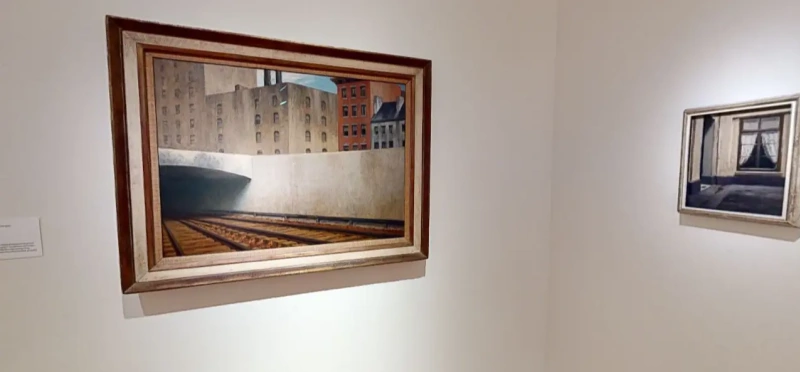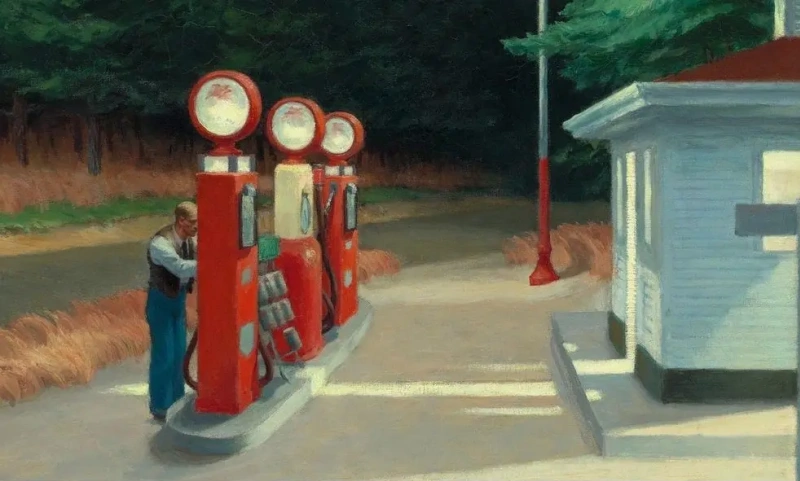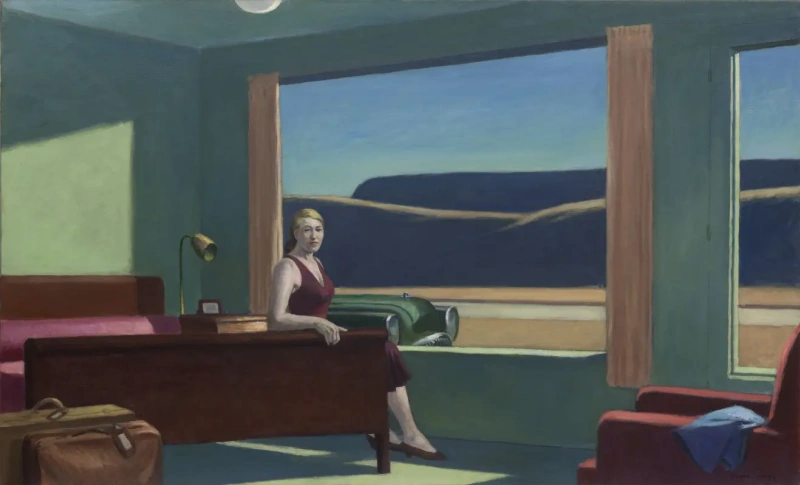log in
Enter site
Login to use Arthive functionality to the maximum
Edward Hopper (22 July 1882, Upper Nyack, USA – 15 May 1967, New York, USA) is an American painter called “the poet of the era” and “the gloomy socialist realist”. Hopper liked painting since early childhood, and his parents supported his desire to become an artist. He learned at the New York Graphics School and the New York Art School. Despite the popularity of avant-garde painting trends, Hopper has always remained true to realism movement. The painter travelled a lot, drawing inspiration in empty freeways and in the streets of different cities.
Creative features of the artist Edward Hopper: he has invented his own special genre, “a portrait of a house”; on his canvases, alone standing buildings often appear. Hopper often painted deserted, seemingly life-deprived urban landscapes. And the stories with people appear to be peeped sneakily.
Famous paintings by Edward Hopper: Nighthawks, House by the Railroad, Self-Portrait,
New York Cinema, Early Sunday Morning, Room In New York.
After the death of Edward Hopper, his wife Jo said to the artist’s biographer, “A New Yorker journalist tried once to write an essay on the Edward’s earthly way. And he could not. There was no material, no illustrations. There was nothing to write about. Only I could write his real biography. And it would be pure Dostoevsky.”
The definition given by Jo is quite consistent with the view about him that developed both during his years of life and after his death. “The poet of empty spaces”, “the gloomy socialist realist”, an artist who praised loneliness... During the century, he had been given many titles. His paintings are still called eerie, full of hopelessness; they are believed to contain echoes of the Great Depression and Pearl Harbour.
Hopper himself just languidly dismissed the tragic comparisons and highbrow epithets, or did not comment the criticism of his works at all. And when being asked to tell what the lone female figure in a meagrely arranged hotel room symbolized, he said in his characteristic low-key manner that he simply wanted to depict how light fell on walls and objects. Sometimes, when you look at his paintings, people there seem to be unnecessary. Though he treated himself to depict completely empty rooms with a sunshine geometric pattern only by the end of his time, in the pictures Rooms by the Sea (1951) and Sun in an Empty Room (1963). Edward Hopper was so eager to move away from people and was so much withdrawn that many connoisseurs of his art are surprised to learn that real African passion raged in his life.
He was born in 1882 into the family of a haberdasher. When Edward was 12, he was 180 centimeters high and rather skinny, that’s why classmates called him grasshopper. The boy was very worried about the jeering, turned inward and remained unconvertable and loathe to close relationship until the end of his life. Painting was the boy’s only escape. So it was quite natural, that he decided to devote himself to art. His parents cultivated the artistic taste in their children, took them to New York from their native Nyack to see art exhibitions and theatrical performances, and encouraged Edward's fascination with painting. However, when young Hopper decided to get a professional education, his father advised him to enter the New York Graphics School to be able to work in the advertising business and earn enough money. Upon completing the debt of an exemplary son, Edward nevertheless entered the New York Art School, and became a disciple of the famous American artist Robert Henry, who belonged to realistic style.
The turning point in his artistic career was three trips to Europe in 1906–1910, mainly to Paris. At this time, the fame of Picasso resonded through the capital of the art world, in particular, his legendary The Girls of Avignon (1907). Edward left the trends unattended (later he said that he did not even listen to Picasso during his visits to Paris), but he fell in love with the works by Paul Cézanne, Claude Monet and Edouard Manet. It was during this period that his first known works were born. But Paris in his paintings did not look the same as it was customarily drawn in paintings and illustrations. The painter showed it in his works not as faceless, but totally unrecognizable. He drew deserted streets, embankments, houses, but nothing said that this was Paris apart from the pictures’ names (Stairway at 48 rue de Lille, Paris, 1906). He could meet the same stairs in any major European (as well as American) city. This is the feature of many his artworks: despite uniqueness of the works themselves, the subjects are absolutely universal.
While many of Edward’s contemporaries burned bright early and faded quickly (e.g., Jackson Pollock died before the age of 45), he himself preferred slow movement, as he only got ready to marry after forty. In 1923, he married his colleague Josephine Nivison, who was only one year younger than him. We do not know exactly how did Edward get on with women before he met Jo, but given his painful shyness, we can assume that he did not have much success with the opposite sex. Newly minted Mrs. Hopper did even keep her innocence before the marriage. Moreover, both of the spouses were grown in ultra-conservative families, therefore it is no wonder that the notorious marital duties became a nightmare for them. Jo considered this part of the married life (as well as the cooking) rather unimportant, as she was more concerned about spiritual needs, and she even proudly noted in her diary that she did not let herself be tempted by her husband.
By the way, this diary has almost been the only source of information about the life and work of Hopper. In it, Jo not only wrote about the hardships of married being and terrible quarrels with Edward, which sometimes even ended in fights, but also scrupulously documented the data analysis about each painting her husband created, about every exhibition he took part in, and about each work sold at these exhibitions.
However, despite the anger, alienation and never-ending domestic squabbles, the couple remained together until his death. Jo fervently supported her husband, although she laughed at the fact that he “does not know how to paint beautiful things”. Because of her, he began to paint artworks in watercolour (The Mansard Roof, 1923), and all women began to acquire her features in Edward’s paintings (Hotel Room, 1931, Morning in a City, 1944). They were not able to become really good spouses, but they made a great creative tandem. Together they came up with the images of his paintings, and Josephine painted the details under each of the sketches in his album. For example, under the sketch for the Nighthawks she wrote what kind of wood the bar counter is made of and how the cylinders in the corner shine under the artificial lighting.
Hopper’s canvases, even those containing absolutely no action at first glance, are united by one striking feature: all of them tell the viewer a story, without exception. And each one has its own plot, and every time it’s a new one.
Reproductions of the artist’s paintings are presented in the Arthive gallery.
Author: Yevheniia Sidelnikova
Leer más
Creative features of the artist Edward Hopper: he has invented his own special genre, “a portrait of a house”; on his canvases, alone standing buildings often appear. Hopper often painted deserted, seemingly life-deprived urban landscapes. And the stories with people appear to be peeped sneakily.
Famous paintings by Edward Hopper: Nighthawks, House by the Railroad, Self-Portrait,
New York Cinema, Early Sunday Morning, Room In New York.
After the death of Edward Hopper, his wife Jo said to the artist’s biographer, “A New Yorker journalist tried once to write an essay on the Edward’s earthly way. And he could not. There was no material, no illustrations. There was nothing to write about. Only I could write his real biography. And it would be pure Dostoevsky.”
The definition given by Jo is quite consistent with the view about him that developed both during his years of life and after his death. “The poet of empty spaces”, “the gloomy socialist realist”, an artist who praised loneliness... During the century, he had been given many titles. His paintings are still called eerie, full of hopelessness; they are believed to contain echoes of the Great Depression and Pearl Harbour.
Hopper himself just languidly dismissed the tragic comparisons and highbrow epithets, or did not comment the criticism of his works at all. And when being asked to tell what the lone female figure in a meagrely arranged hotel room symbolized, he said in his characteristic low-key manner that he simply wanted to depict how light fell on walls and objects. Sometimes, when you look at his paintings, people there seem to be unnecessary. Though he treated himself to depict completely empty rooms with a sunshine geometric pattern only by the end of his time, in the pictures Rooms by the Sea (1951) and Sun in an Empty Room (1963). Edward Hopper was so eager to move away from people and was so much withdrawn that many connoisseurs of his art are surprised to learn that real African passion raged in his life.
The Lifelong Battle
Edward Hopper lived for almost 85 years, and most of his life he had to fight his way, break through and defend the recognition of his works’ value. Once impressed by the French impressionists (in 1962, he said that he still considered himself an impressionist), he stubbornly painted extremely realistic landscapes, interiors and portraits, which faced him with a necessity of fighting for popularity with a numerous army of disparate cubists, surrealists, abstractionists and avant-gardists. While his desire to adhere to the classical canons was not an attempt to form an opposition to the fashionable trends, but his hopeless conservative style of living.He was born in 1882 into the family of a haberdasher. When Edward was 12, he was 180 centimeters high and rather skinny, that’s why classmates called him grasshopper. The boy was very worried about the jeering, turned inward and remained unconvertable and loathe to close relationship until the end of his life. Painting was the boy’s only escape. So it was quite natural, that he decided to devote himself to art. His parents cultivated the artistic taste in their children, took them to New York from their native Nyack to see art exhibitions and theatrical performances, and encouraged Edward's fascination with painting. However, when young Hopper decided to get a professional education, his father advised him to enter the New York Graphics School to be able to work in the advertising business and earn enough money. Upon completing the debt of an exemplary son, Edward nevertheless entered the New York Art School, and became a disciple of the famous American artist Robert Henry, who belonged to realistic style.
The turning point in his artistic career was three trips to Europe in 1906–1910, mainly to Paris. At this time, the fame of Picasso resonded through the capital of the art world, in particular, his legendary The Girls of Avignon (1907). Edward left the trends unattended (later he said that he did not even listen to Picasso during his visits to Paris), but he fell in love with the works by Paul Cézanne, Claude Monet and Edouard Manet. It was during this period that his first known works were born. But Paris in his paintings did not look the same as it was customarily drawn in paintings and illustrations. The painter showed it in his works not as faceless, but totally unrecognizable. He drew deserted streets, embankments, houses, but nothing said that this was Paris apart from the pictures’ names (Stairway at 48 rue de Lille, Paris, 1906). He could meet the same stairs in any major European (as well as American) city. This is the feature of many his artworks: despite uniqueness of the works themselves, the subjects are absolutely universal.
From Love to Hate
Many important events happened for Hopper quite late, especially as we understand it. His first solo exhibition took place when the painter was 37 years old. Until that moment, his artworks were shown among the works of other artists, but they remained without attention. However, a solo exhibition demonstrating his 16 paintings had little effect on the situation. Fame came to him after many years.While many of Edward’s contemporaries burned bright early and faded quickly (e.g., Jackson Pollock died before the age of 45), he himself preferred slow movement, as he only got ready to marry after forty. In 1923, he married his colleague Josephine Nivison, who was only one year younger than him. We do not know exactly how did Edward get on with women before he met Jo, but given his painful shyness, we can assume that he did not have much success with the opposite sex. Newly minted Mrs. Hopper did even keep her innocence before the marriage. Moreover, both of the spouses were grown in ultra-conservative families, therefore it is no wonder that the notorious marital duties became a nightmare for them. Jo considered this part of the married life (as well as the cooking) rather unimportant, as she was more concerned about spiritual needs, and she even proudly noted in her diary that she did not let herself be tempted by her husband.
By the way, this diary has almost been the only source of information about the life and work of Hopper. In it, Jo not only wrote about the hardships of married being and terrible quarrels with Edward, which sometimes even ended in fights, but also scrupulously documented the data analysis about each painting her husband created, about every exhibition he took part in, and about each work sold at these exhibitions.
However, despite the anger, alienation and never-ending domestic squabbles, the couple remained together until his death. Jo fervently supported her husband, although she laughed at the fact that he “does not know how to paint beautiful things”. Because of her, he began to paint artworks in watercolour (The Mansard Roof, 1923), and all women began to acquire her features in Edward’s paintings (Hotel Room, 1931, Morning in a City, 1944). They were not able to become really good spouses, but they made a great creative tandem. Together they came up with the images of his paintings, and Josephine painted the details under each of the sketches in his album. For example, under the sketch for the Nighthawks she wrote what kind of wood the bar counter is made of and how the cylinders in the corner shine under the artificial lighting.
Memento Portrait
Edward Hopper, who only has gained his fame in his last years (and in fact, even after his death), nevertheless, bears the proud title of “poet of the era”. He had a major impact on American pop culture. He had actually invented a new genre, a portrait of a house, which made buildings the main characters in the paintings (House at Dusk, 1935), and later this technique was used in the cinema. David Lynch, film director, called Hopper one of his favourite artists; Lynch is a great lover of deserted motorways, mysterious houses and vague hints.Hopper’s canvases, even those containing absolutely no action at first glance, are united by one striking feature: all of them tell the viewer a story, without exception. And each one has its own plot, and every time it’s a new one.
Reproductions of the artist’s paintings are presented in the Arthive gallery.
Author: Yevheniia Sidelnikova
-
Las obras han gustado705 users
- Artworks in 4 collections and 482 selections
出版物
展览
画家的所有展览
奥尔良的肖像
1950, 66×101.6 厘米

东风超过Vihoken
1934, 86.4×127.6 厘米

半岛K-Ann
1928, 71.1×102.2 厘米

Office in a small town
1953, 71.1×101.6 厘米

Rooms by the sea
1951, 73.7×102 厘米

Нью-йоркский кинотеатр
1939, 81.9×101.9 厘米

Jo drawing
1936, 45.7×40.6 厘米

Self-portrait
1930, 64.5×51.8 厘米

Pharmacy
1927, 73.6×101.9 厘米

Davis House
1926, 35.7×50.8 厘米

House by the railroad
1925, 61×73.7 厘米

Gas
1940, 66.6×102.2 厘米
消息
惠特尼精选奖:1900年-1965年exhibition finished

28 六月 2020 − 1 五月 2022 惠特尼美国艺术博物馆, New York City, Gansevoort Street,99












